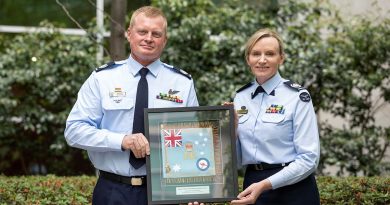Sights set on glacial trifecta

Having just celebrated the one-year anniversary of a 62-day expedition to the South Pole, Warrant Officer Class Two (WO2) Sean Taylor is hungry for the next challenge in the Polar Trifecta.
CAPTION: Australian and New Zealand Defence Force members, from left, Petty Officer Vincent Carlsen, ex-sailors Kelly Kavanagh, Durham (Jack) Forbes and Sean (Squizz) Taylor skied for 62 days to reach the South Pole. Story by Captain Krysten Clifton. Photos by Kelly Kavanagh.
The trifecta comprises expeditions to the North Pole, South Pole and a traverse of Greenland using skis and kites.
“Now that the year is gone and we’ve reflected, we were starting to look at each other as to what’s next,” WO2 Taylor said.
“We’re looking to do the traverse of Greenland perhaps in 2025-2026.”
The traverse will take about 25 days, covering about 600km and braving temperatures down to minus 30 degrees Celsius.
As expeditioners approach the ice sheet, the largest in the world outside Antarctica, polar bears will be a concern, as well as instability of the ice sheet.
WO2 Taylor’s trip to Antarctica was an opportunity to flex his Army skill and experience in an unforgiving environment, advantages he will take to Greenland.
“I look back at my Army career and Antarctica, and they teach you to be squared away with your morning and evening routines – a soldier’s bread and butter,” he said.
“Poor organisation will have dramatic consequences in Antarctica, or even in other environments. What you do in the snow to get yourself organised and ready is no different to the jungle, or at sea or in the desert. You look after your equipment, look after yourselves and your mates, and keep your morning and night routine.”
CAPTION: The contents of the sleds used by the team of Australian and New Zealand Defence Force members who trekked to the South Pole in 2023.
WO2 Taylor’s South Pole journey began five years beforehand when he was one of more than 300 people to put their names down for the expedition. His tenacity and passion resulted in him being one of only four Australian and New Zealand Defence Force members to reach the Pole.
After a trip to Norway, COVID-19 and a host of other factors, the number of people heading to Antarctica was whittled down to six. Luckily, and thanks to some strong teamwork, the same six also made it out of Antarctica, though not all having completed their goal.
“One of the team members was really struggling nutrition wise, as in they couldn’t keep the food down,” WO2 Taylor said.
“That makes them weaker and they then get colder. I was on 7000 calories of food a day for what I was burning – a heavy diet of butter, cheese, salami, dehydrated meals and chocolate. You never know unless you do a long expedition like that what your body will tolerate.
“About seven days to the halfway point, the rest of the team split up the member’s gear and carried it. You don’t argue about it, that’s what you have to do.”
Luckily, two team members were able to catch a lift back to base at the halfway point, where the team was restocked.
“It’s 24 hours of sunlight. The sun never sets in summer so you’re trying to get used to sleeping when the sun is up,” WO2 Taylor said.
“The coldest weather we had was closer to the Pole, about minus 35 with a wind chill factor of just under minus 48. That’s where the teamwork comes in as well, looking at each other on really cold days and making sure there’s no exposed skin, because frost bite will happen very quickly.”
Unfortunately, disaster struck the team again when another member began to show signs of altitude sickness. The South Pole sits at an altitude of 2835m, just 607m below Mt Kosciuszko.
“He started going blue in the lips and was struggling to breathe. It was a really big scare,” WO2 Taylor said.
“We had to adjust our timings again for him to get proper sleep, good nutrition and try to work out why his body was reacting to the atmospheric conditions. He struggled with that for up to two weeks, then as we got closer to the Pole the mind focused on different things.
“About 30km from when you get to the South Pole you can start to see the base, almost like a mirage in the desert. Once you see that for two days you get pretty excited knowing the next day you’ll reach the South Pole. The struggles disappear, the talk changes.”
The team reached the South Pole on January 18, 2023, an emotional time for them all and the culmination of more than five years of work. After 62 days, WO2 Taylor was finally able to enjoy a good meal and a beer.
A year later and he’s gone full circle – back to the planning, saving and dreaming of another mission. With such a dangerous, exhausting and protracted journey ahead, one wouldn’t be alone in asking, why?
“We all get comfortable in Defence with the job you do, but it’s putting people out of their comfort zone and testing that resilience that will benefit the individual and increase skills on the battlefield,” WO2 Taylor said.
“I think of why you would want to join Defence and in most cases that person has to have some sort of understanding of independence, be resilient by nature and enjoy the outdoors.
“Traits of why you would want to be in the Army flow through to why you would want to do something like this.”
.
.

.
.






